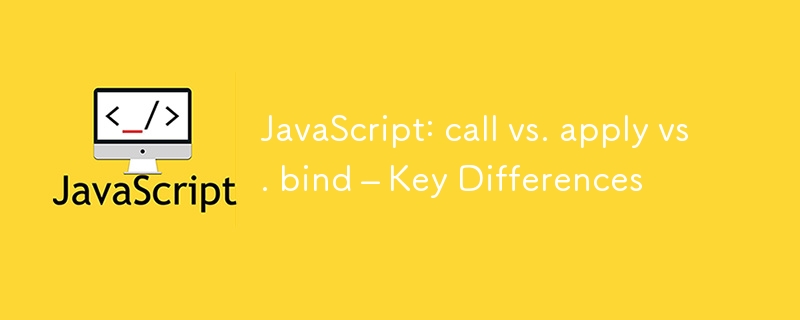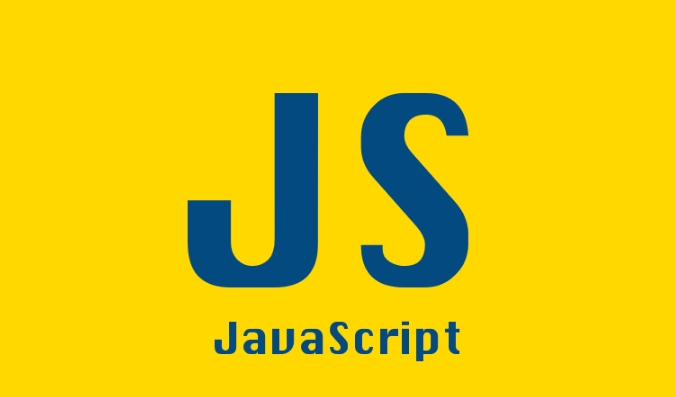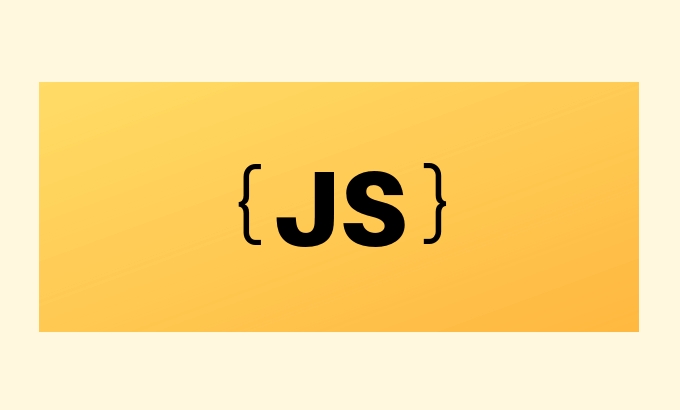The difference between call, apply and bind is the call method and parameter passing: 1.call executes the function immediately and passes parameters one by one; 2. apply executes the function immediately but passes parameters in an array; 3.bind does not execute the function but returns the bound new function, which is suitable for delayed calls. In addition, bind also supports preset parameters to implement partial function applications.

call , apply and bind in JavaScript seem to be used to change this pointing when function execution, but there are still obvious differences between them. Understanding their respective features and applicable scenarios will allow you to control the function context more flexibly when writing code.

call and apply: call the function and specify this
The main function of these two methods is the same - calling a function and specifying this value inside the function . The difference is that the parameters are passed in different ways:
-
call(thisArg, arg1, arg2, ...)
Parameters are passed in sequence, suitable for the case where the specific number of parameters is known.
apply(thisArg, [argsArray])
The second parameter is an array or class array object, suitable for cases where the number of parameters is not fixed or there is already an array.
For example:

function greet(greeting, punctuation) {
console.log(greeting ', ' this.name punctuation);
}
const person = { name: 'Alice' };
greet.call(person, 'Hello', '!'); // Hello, Alice!
greet.apply(person, ['Hi', '!!']); // Hi, Alice!! As you can see, the functions of the two are almost the same, but the transmission methods are slightly different. If you already have an array, use apply ; if the parameters are clear, use call is more intuitive.
bind: bind this and return a new function
The function of bind is to change this inside the function, but it does not execute the function immediately , but returns a new function, which can be called later.
The syntax is as follows:
function.bind(thisArg, arg1, arg2, ...)
This feature makes it very suitable for use in scenarios such as event processing, callback functions, etc. that require delayed execution.
for example:
function saysHi() {
console.log('Hi, I am ' this.name);
}
const user = { name: 'Bob' };
const boundSayHi = sayHi.bind(user);
boundSayHi(); // Hi, I am Bob Here sayHi.bind(user) returns a new function that binds this to user . No matter how it is called, this.name is 'Bob' .
Use scenario comparison
| method | Whether to execute immediately | Parameter form | Typical uses |
|---|---|---|---|
| call | yes | Pass the parameters one by one | Pass the parameters accurately and call it immediately |
| apply | yes | Array parameter transfer | Used when the parameters are unknown or there is already an array |
| bind | no | Pass the parameters one by one (partial) | Delayed call after binding the context |
You may encounter such a situation:
- When calling the parent class constructor, use
callorapply; - When performing "borrow" operations on an array, such as
[].slice.apply(arguments); - When binding a function to the DOM event, use
bindto ensure thatthisis not lost.
Small details: bind can also be used as partial application (Partial Application)
In addition to binding this , bind also supports preset partial parameters, which is particularly useful in some scenarios.
for example:
function multiply(a, b) {
return a * b;
}
const double = multiply.bind(null, 2);
console.log(double(5)); // 10 Here we set the first parameter to 2 and create a new double function. This technique is called "partial function application" and can simplify subsequent calls.
Basically that's it. The three methods perform their duties: call and apply are called immediately, the difference is only in the pass parameter method; bind is to return a new function after binding, which is suitable for delayed calls. Mastering their differences will allow you to control the function execution environment more easily in JavaScript.
The above is the detailed content of JavaScript: call vs. apply vs. bind – Key Differences. For more information, please follow other related articles on the PHP Chinese website!

Hot AI Tools

Undress AI Tool
Undress images for free

Undresser.AI Undress
AI-powered app for creating realistic nude photos

AI Clothes Remover
Online AI tool for removing clothes from photos.

Clothoff.io
AI clothes remover

Video Face Swap
Swap faces in any video effortlessly with our completely free AI face swap tool!

Hot Article

Hot Tools

Notepad++7.3.1
Easy-to-use and free code editor

SublimeText3 Chinese version
Chinese version, very easy to use

Zend Studio 13.0.1
Powerful PHP integrated development environment

Dreamweaver CS6
Visual web development tools

SublimeText3 Mac version
God-level code editing software (SublimeText3)

Hot Topics
 Java vs. JavaScript: Clearing Up the Confusion
Jun 20, 2025 am 12:27 AM
Java vs. JavaScript: Clearing Up the Confusion
Jun 20, 2025 am 12:27 AM
Java and JavaScript are different programming languages, each suitable for different application scenarios. Java is used for large enterprise and mobile application development, while JavaScript is mainly used for web page development.
 Mastering JavaScript Comments: A Comprehensive Guide
Jun 14, 2025 am 12:11 AM
Mastering JavaScript Comments: A Comprehensive Guide
Jun 14, 2025 am 12:11 AM
CommentsarecrucialinJavaScriptformaintainingclarityandfosteringcollaboration.1)Theyhelpindebugging,onboarding,andunderstandingcodeevolution.2)Usesingle-linecommentsforquickexplanationsandmulti-linecommentsfordetaileddescriptions.3)Bestpracticesinclud
 Javascript Comments: short explanation
Jun 19, 2025 am 12:40 AM
Javascript Comments: short explanation
Jun 19, 2025 am 12:40 AM
JavaScriptcommentsareessentialformaintaining,reading,andguidingcodeexecution.1)Single-linecommentsareusedforquickexplanations.2)Multi-linecommentsexplaincomplexlogicorprovidedetaileddocumentation.3)Inlinecommentsclarifyspecificpartsofcode.Bestpractic
 JavaScript Data Types: A Deep Dive
Jun 13, 2025 am 12:10 AM
JavaScript Data Types: A Deep Dive
Jun 13, 2025 am 12:10 AM
JavaScripthasseveralprimitivedatatypes:Number,String,Boolean,Undefined,Null,Symbol,andBigInt,andnon-primitivetypeslikeObjectandArray.Understandingtheseiscrucialforwritingefficient,bug-freecode:1)Numberusesa64-bitformat,leadingtofloating-pointissuesli
 JavaScript vs. Java: A Comprehensive Comparison for Developers
Jun 20, 2025 am 12:21 AM
JavaScript vs. Java: A Comprehensive Comparison for Developers
Jun 20, 2025 am 12:21 AM
JavaScriptispreferredforwebdevelopment,whileJavaisbetterforlarge-scalebackendsystemsandAndroidapps.1)JavaScriptexcelsincreatinginteractivewebexperienceswithitsdynamicnatureandDOMmanipulation.2)Javaoffersstrongtypingandobject-orientedfeatures,idealfor
 How to work with dates and times in js?
Jul 01, 2025 am 01:27 AM
How to work with dates and times in js?
Jul 01, 2025 am 01:27 AM
The following points should be noted when processing dates and time in JavaScript: 1. There are many ways to create Date objects. It is recommended to use ISO format strings to ensure compatibility; 2. Get and set time information can be obtained and set methods, and note that the month starts from 0; 3. Manually formatting dates requires strings, and third-party libraries can also be used; 4. It is recommended to use libraries that support time zones, such as Luxon. Mastering these key points can effectively avoid common mistakes.
 JavaScript: Exploring Data Types for Efficient Coding
Jun 20, 2025 am 12:46 AM
JavaScript: Exploring Data Types for Efficient Coding
Jun 20, 2025 am 12:46 AM
JavaScripthassevenfundamentaldatatypes:number,string,boolean,undefined,null,object,andsymbol.1)Numbersuseadouble-precisionformat,usefulforwidevaluerangesbutbecautiouswithfloating-pointarithmetic.2)Stringsareimmutable,useefficientconcatenationmethodsf
 Why should you place tags at the bottom of the ?
Jul 02, 2025 am 01:22 AM
Why should you place tags at the bottom of the ?
Jul 02, 2025 am 01:22 AM
PlacingtagsatthebottomofablogpostorwebpageservespracticalpurposesforSEO,userexperience,anddesign.1.IthelpswithSEObyallowingsearchenginestoaccesskeyword-relevanttagswithoutclutteringthemaincontent.2.Itimprovesuserexperiencebykeepingthefocusonthearticl







